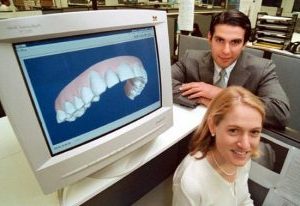Invisalign® aligners are designed, manufactured , and marketed by Align technology which is a medical device company headquartered in San Jose,California. The company was founded in March 1997 by Zia Chisti and Kelsey Wirth two Stanford MBA students (pictured below).
Zia Chisti (standing) and Kelsey Wirth.
Zia Chisti was an adult orthodontic patient and noticed that when his retainer (removable orthodontic appliance) was inserted that it effected very minor movements of his teeth. He conjectured that if an incremental sequence of such retainers (removable appliances) were used that more substantial tooth movement could be achieved. Christi and Wirth worked with two fellow Stanford students Apostolos Lerios (who at the time was a PhD student in computer science) and Brian Freyburger (a computer science student ) to develop invisalign. They demonstrated extraordinary innovation to develop the appliance (invisalign®) , it required intensive research in modeling, computer-aided design (CAD) , digital capture of the geometry of objects, and three dimensional (3D ) printing technology( stereolithography ). They had combined a potent team of students with computer and manufacturing skills along with financial and business skills. It is notable that none of the founders had a backround in dentistry. They registered 15 patents for their technology. They secured significant venture capital funding, though they initially experienced difficulty in attracting investors to their company, and were turned down by many potential investors. They received FDA (Food and Drug Administration) approval in 1998 to market the appliance. The first appliances (aligners) were sold in the U.S.A in 1999.
An article in the Business section of the New York times in Aug 2000 describes how Align intended to spend $31 million dollars in a television advertising campaign , that was the first of its kind, in that it was an orthodontics company advertising directly to the public rather than to orthodontists or dentists . This unprecedented advertising campaign was intended to generate interest amongst adults in having orthodontic treatment with Invisalign®.
Many orthodontists were skeptical about this new appliance , especially since none of the founders had a backround in dentistry. This presented orthodontists with a significant dilemma. It was largely anticipated at the time that the orthodontic results which this appliance would achieve would be inferior to those achieved with the conventional fixed appliances (braces ,railway tracks of the metal or ceramic type).This was a major departure for the orthodontic profession, as in general up until this time, new orthodontic appliances were only adopted if they at least equaled or superseded the orthodontic results of the appliances which preceded them. However given the enormous consumer demand which the “direct to public ” advertising campaign generated, the majority of orthodontists in the USA in 2000 decided to “go with the flow ” and attend certification courses so that they would be recognised as an “Invisalign® provider”, in their locality.
Since then there have been many developments in the Invisalign® appliance and consequently the quality of results which it achieves has steadily improved, along with a broadening in the scope of the appliance to treat more complex orthodontic problems.
This orthodontic blog was written by Dr John Buckley who is a specialist orthodontist at Clonmel Orthodontics in Riverhouse orthodontic practice in Clonmel County Tipperary, Ireland. They provide orthodontics to county Tipperary and the neighbouring counties of Waterford, kilkenny, Limerick and Cork , and beyond.
Dr Buckley has practised as a specialist orthodontist in Clonmel for 20 years. In addition to his orthodontic qualifications which he held before he commenced orthodontic practice , Dr Buckley was awarded a First class masters degree in Lingual orthodontics from the University of Hannover medical school (MHH) in 2012. This masters degree is directed by Professor Dirk Wiechmann who is the inventor of both the incognito™ and win™ lingual appliances. Dr Buckley was the first orthodontist in Ireland to be awarded this qualification. In 2016 he was accepted as an active member of the European Society Of Lingual Orthodontics (ESLO). To become an active member it is necessary for candidates to submit the records of finished lingual cases. If the cases are deemed to be of a sufficiently high standard then the candidate is accepted as an active member of ESLO. Dr Buckley is the first orthodontist in Ireland to be accepted as an active member of ESLO.


